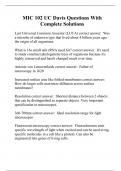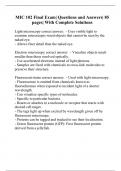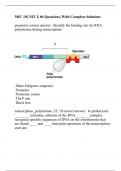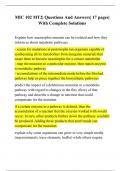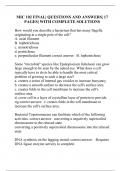Mic 102 - Study guides, Class notes & Summaries
Looking for the best study guides, study notes and summaries about Mic 102? On this page you'll find 165 study documents about Mic 102.
Page 4 out of 165 results
Sort by
MIC 102 UC Davis Questions With Complete Solutions
MIC 102 Final Exam| Questions and Answers| 85 pages| With Complete Solutions
MIC 102 MT 2| 86 Questions| With Complete Solutions
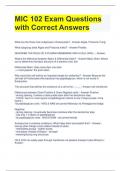
-
MIC 102 Exam Questions with Correct Answers
- Exam (elaborations) • 17 pages • 2023
-
Available in package deal
-
- $13.99
- + learn more
MIC 102 Exam Questions with Correct Answers What are the three main subgroups of Eukaryotes? - Answer-Algae, Protozoa, Fungi What subgroup does Algae and Protozoa make? - Answer-Protists DESCRIBE THE ROLE OF A PLASMA MEMBRANE AND A CELL WALL. - Answer- What's the difference between Basic & Differential Stain? - Answer-Basic Stain: Allows you to determine the basic structure of a bacteria (rod, etc) Differential Stain: Uses more than one stain --> most popular: the gram stain. ...
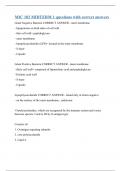
-
MIC 102 MIDTERM 1 questions with correct answers
- Exam (elaborations) • 16 pages • 2023
- Available in package deal
-
- $14.99
- + learn more
Gram Negative Bacteria CORRECT ANSWER - inner membrane - lipoproteins on both sides of cell wall - thin cell wall= peptidoglycan - outer membrane - lipopolysaccharides (LPS)= located in the outer membrane - S-layer - Capsule Gram Positive Bacteria CORRECT ANSWER - inner membrane - thick cell wall= composed of lipoteichoic acid and peptidoglycan -Teichoic acid wall - S-layer - Capsule Lipopolysaccharide CORRECT ANSWER - found only in Gram negative - on the surface of the outer...
MIC 102 MT2| Questions And Answers| 17 pages| With Complete Solutions
MIC 102 FINAL| QUESTIONS AND ANSWERS| 17 PAGES| WITH COMPLETE SOLUTIONS
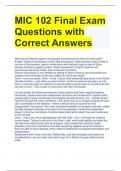
-
MIC 102 Final Exam Questions with Correct Answers
- Exam (elaborations) • 20 pages • 2023
-
Available in package deal
-
- $13.49
- + learn more
MIC 102 Final Exam Questions with Correct Answers What are the different types of microscopy and staining and when are they used? - Answer-Types of microscopy include: light microscopy- used primarily to get an idea of the form of the bacteria, used in combination with staining to get an idea of Gram positive and Gram negative protein. Green fluorescent is used to observe cell occurrences like binary fission and movement of proteins. Electron microscopy is very detailed at getting an idea of ...
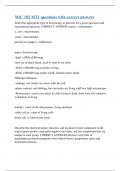
-
MIC 102 MT1 questions with correct answers
- Exam (elaborations) • 15 pages • 2023
- Available in package deal
-
- $14.99
- + learn more
Select the appropriate type of microscopy to perform for a given specimen and experimental question. CORRECT ANSWER viruses-->nanometers e. coli-->micrometers yeast-->micrometers period (on a page)-->millimeters types of microscopy -light: x1000-x2000 mag can't see in much detail, need to stain to see more -TEM: x500,000 mag (exterior; living) -SEM: x500,000 mag (really small; internal struct; dead) labeling techniques -staining: can clearly see struct, kills the cell -...
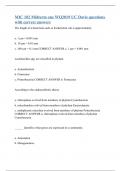
-
MIC 102 Midterm one WQ2019 UC Davis questions with correct answers
- Exam (elaborations) • 20 pages • 2023
- Available in package deal
-
- $16.49
- + learn more
The length of a bacterium such as Escherichia coli is approximately a. 1 µm = 0.001 mm b. 10 µm = 0.01 mm c. 100 µm = 0.1 mm CORRECT ANSWER a. 1 µm = 0.001 mm Lactobacillus spp. are classified in phylum a. Actinobacteria b. Firmicutes c. Proteobacteria CORRECT ANSWER b. Firmicutes According to the endosymbiotic theory a. chloroplasts evolved from members of phylum Cyanobacteria b. mitochondria evolved from members of phylum Euryarchaeota c. endoplasmic reticulum evolved ...

How did he do that? By selling his study resources on Stuvia. Try it yourself! Discover all about earning on Stuvia

